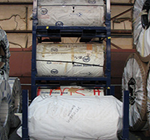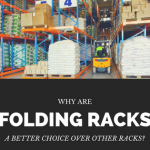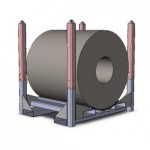
Enhancing Storage Efficiency with Custom Coil Racking Solutions
Custom coil storage racking systems are specifically designed to meet the unique needs of industries that handle coils and cylindrical materials. Unlike standard pallet racks, these racking systems provide tailored solutions that optimize space utilization and improve inventory management.
a. Maximized Vertical Space: Custom coil racking solutions make excellent use of vertical storage space, enabling businesses to store coils at varying heights while maintaining easy access. By capitalizing on the vertical dimension, facilities can significantly increase their storage capacity without expanding their physical footprint.
b. Modular Configurations: These systems can be configured to accommodate coils of different sizes and weights, making them highly adaptable to changing inventory needs. For example, modular coil storage cradles can be added or adjusted to cater to varying coil diameters, offering unparalleled flexibility.
c. Optimized Layouts: Tailored racking layouts ensure that the storage area is designed for streamlined workflows. With custom coil storage racking, businesses can position racks to support efficient loading, unloading, and movement of goods, reducing operational bottlenecks.
Improving Workplace Safety
Workplace safety is of utmost importance for industries dealing with heavy coils. Improper storage and handling may lead to accidents, equipment damage and financial losses – custom coil storage rack systems designed with safety in mind can offer many advantages:
a. Stability and Durability: Built from robust materials, these racking systems are constructed to bear significant loads without tipping or collapsing under pressure – even when used for coil storage of several tons or more.
b. Secure Storage: Coil storage cradles provide secure coil storage by preventing unnecessary movement or rolling, thus decreasing workplace accidents caused by shifting loads.
c. Ergonomic Handling: Custom racking systems often integrate ergonomic features, such as forklifts or crane access points, into their designs to facilitate safe material handling while decreasing worker injuries during loading and unloading operations.
d. Compliance with Safety Standards: By investing in engineered coil racking solutions, businesses can ensure compliance with occupational health and safety regulations, helping avoid fines while building their company’s reputation as a safe workplace.
Cost Efficiency and Long-Term Savings
While custom coil storage racking systems may incur higher upfront costs compared to their standard counterparts, their long-term advantages make them an economical investment for businesses.
a. Reduced Material Damage: Well-designed coil storage solutions reduce the risk of material damage caused by improper stacking or storage methods, keeping coils intact while also preserving quality and reducing wastage.
b. Lower Labor Costs: Efficient racking systems streamline workflows, enabling workers to manage materials more quickly and with reduced effort – thus cutting labor hours and costs significantly.
c. Minimized Downtime: Better organization and accessibility enable faster material retrieval times, which decrease operational downtime while simultaneously increasing productivity.
d. Longevity and Durability: Coil rack solutions from custom coil racking suppliers are built to last, offering years of reliable service while producing an optimal return on investment over the long run.
Tailored Solutions for Diverse Industries
Custom coil storage racking systems offer tailored solutions to businesses across industries, providing tailored solutions specifically tailored for each. Here are a few industries which benefit from such systems:
a. Manufacturing: When dealing with raw materials like steel or aluminum coils, manufacturers require custom coil storage racks for an organized production environment and easy coil access, thus decreasing downtime during manufacturing processes. These storage solutions allow producers to optimize efficiency.
b. Logistics and Warehousing: Logistics companies require efficient storage and rapid retrieval to remain profitable. Coil racking solutions streamline inventory management, enabling warehouses to store high volumes of cylindrical products efficiently.
c. Construction: Construction firms often need access to materials like cable spools and rebar coils for construction sites. Custom racking systems offer secure storage for these items so that they remain in top condition while still being easily available when necessary on-site.
d. Automotive: Automotive manufacturing often relies on metal sheets and coils. Coil storage cradles help maintain these materials for consistent product quality in finished goods.
Environmental Benefits
In addition to providing operational and safety advantages, custom coil storage racking systems also contribute toward businesses’ environmental sustainability goals by improving storage efficiency and reducing material wastage – thus helping reduce their environmental footprint.
a. Reduced Footprint: Vertical storage systems enable businesses to store more materials within the same footprint, saving space and resources while saving land for development projects.
b. Extended Material Lifespan: Proper storage conditions offered by coil racking solutions help extend material lifespan, thus decreasing replacement frequency.
c. Efficient Use of Resources: Businesses can make better use of raw materials by minimizing material handling errors and damage, supporting their sustainability goals in this way.
Innovations in Custom Coil Storage Racking Systems
With advances in technology, coil storage racking systems have become more advanced, boasting new features to increase their functionality:
a. Automated Systems: Automation is revolutionizing the storage and retrieval process. Automated coil racking solutions integrate seamlessly with warehouse management systems (WMS), providing precise inventory tracking and efficient material handling.
b. Adjustable Cradles: Modern racking systems often include coil storage cradles with adjustable mechanisms that enable businesses to accommodate a wide variety of coil sizes without making extensive modifications to their system.
c. Safety Sensors: Cutting-edge safety features like load sensors and alert systems provide real-time monitoring to detect overloading and ensure smooth operations.
d. Customizable Designs: From powder-coated finishes to corrosion-resistant materials, customized racking solutions can be tailored to withstand specific environmental conditions like high humidity or extreme temperatures.
Selecting the Right Coil Racking System for Your Needs
Selecting an ideal custom coil storage racking system requires careful consideration of various factors:
a. Load Capacity: Make sure that it can safely support the weight of your heaviest coils without compromising safety or stability.
b. Space Constraints: Evaluate the available space at your facility and explore vertical storage as a potential way of increasing capacity.
c. Coil Dimensions: When choosing a system for handling coil sizes you regularly handle, include features that enable flexibility with this versatile selection process.
d. Material Handling Requirements: Care should be taken when choosing the equipment used for loading and unloading materials, such as forklifts or overhead cranes, to ensure compatibility with the racking system.
e. Future Scalability: Choose a solution that can expand or adapt as your storage requirements change, such as flexible shelving systems that can meet growing storage demands.
Conclusion
Custom coil storage racking systems provide industries that work with cylindrical materials with numerous advantages. By increasing storage efficiency, improving workplace safety and providing tailored solutions tailored to specific storage requirements, these systems offer exceptional value and long-term savings. Furthermore, technological innovations continue to expand their functionality, so businesses can meet evolving storage requirements effectively.
















































